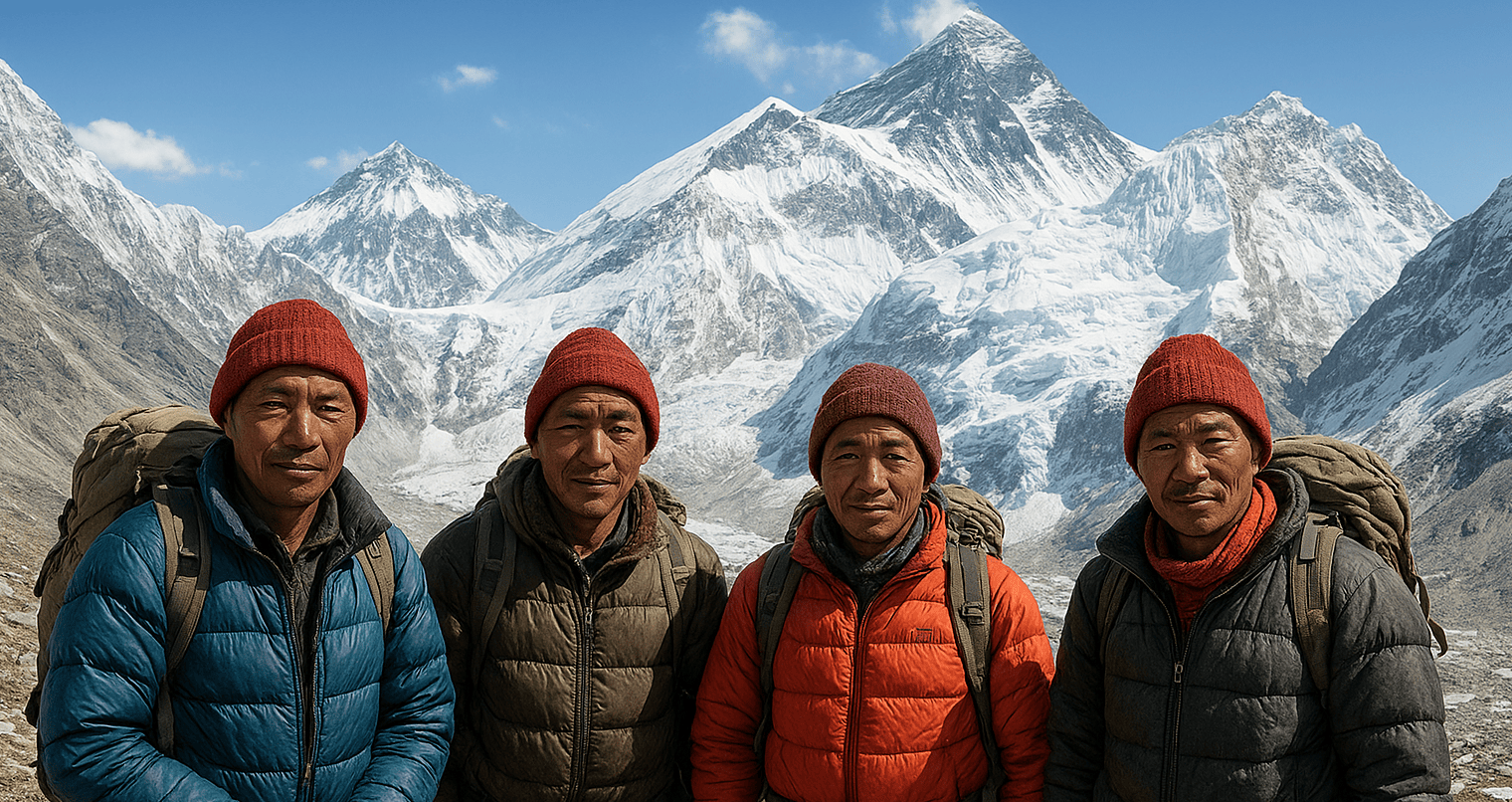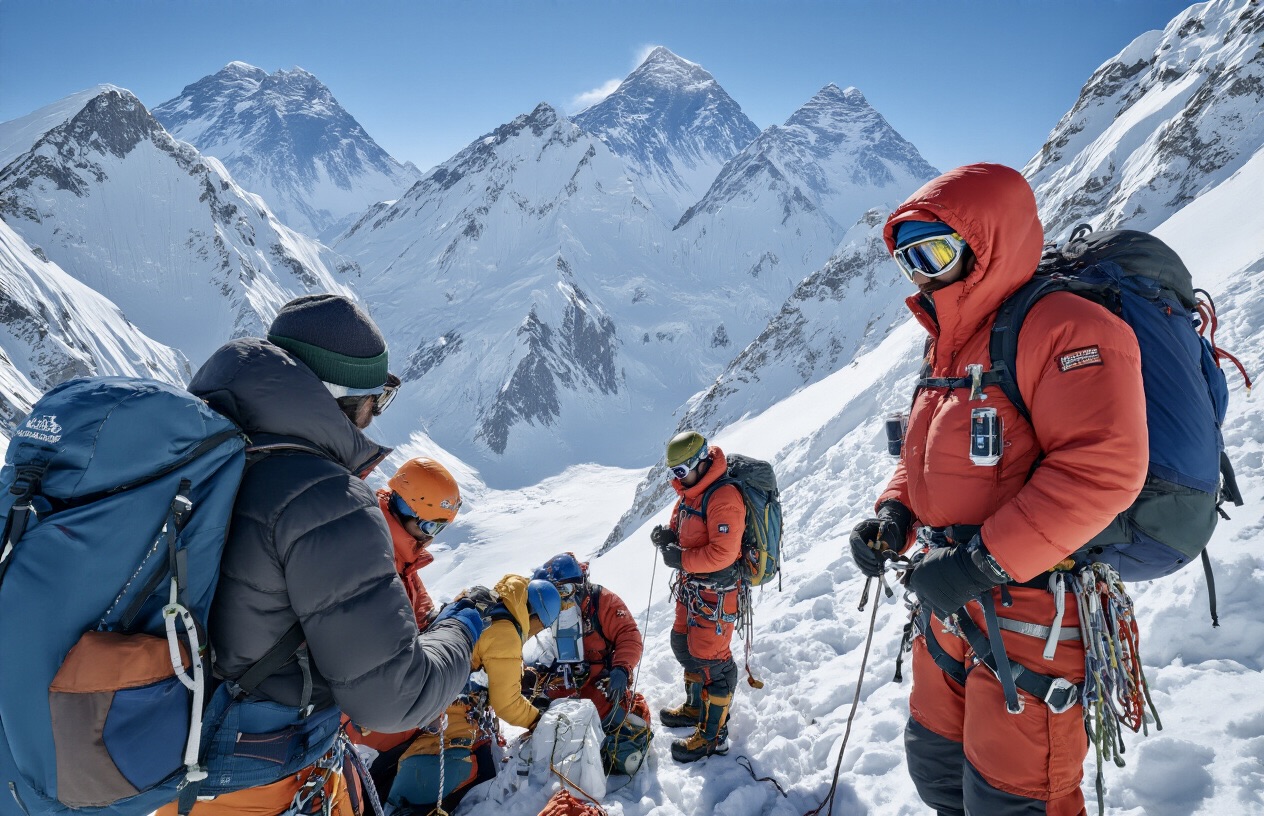Nepal's Himalayas, home to eight of the world's fourteen tallest peaks, attract climbers and adventurers from around the globe. What is often not recognized as part of the thrilling adventure of high-altitude success is the central role of a Sherpa - indigenous mountain people of the Khumbu and adjacent regions. Having traversed these rugged terrains for generations, Sherpas are the beating heart of each expedition, for success or not. Sherpas are masters of this terrain based on this knowledge and not recently acquired experience - an extraordinary human physical endurance and leadership with temperate calm in extreme conditions.
Sherpas do much more than carry loads; they are expert guides, rope-fixers, high camp managers, and medical responders. Sherpas have responsibilities that extend far earlier than the ascent, and finish long after everyone is back down and safely off the mountain. As guardians of the high Himalaya, Sherpas embody the discipline, resilience, and spirituality that govern what is true mountaineering, and they facilitate the ascent for the mountain climbers. Without Sherpas, most expeditions would simply not happen in Nepal.

The Backbone of Himalayan Climbing
Sherpas are more than guides — they are the soul of the mountains. Indigenous to the high-altitude regions of eastern Nepal, Sherpas possess unique physiological adaptations, such as enhanced oxygen processing, making them naturally suited for life above 3,000 meters. But it’s not just biology; it’s a deep cultural connection to the Himalayas that drives their unmatched commitment and resilience.
From the early days of Himalayan exploration to the modern age of commercial expeditions, Sherpas have been at the forefront — paving paths, hauling loads, fixing ropes, setting camps, and often sacrificing their safety for the success of others. The success of Everest expeditions and numerous other peaks would simply not be possible without their expertise and courage.
Guiding and Navigation
Sherpas possess unparalleled knowledge of the mountain landscape, weather behavior, and seasonal conditions. This expertise is born of generations of experience and honed through professional training.
-
Route Selection: Sherpas identify the safest and most efficient paths to the summit, often making crucial decisions when conditions change. Their ability to assess the terrain and weather allows them to adapt routes as necessary, ensuring climbers can navigate safely.
-
Terrain Mastery: They help climbers navigate through icefalls, crevasses, steep ridgelines, and avalanche-prone zones with calculated precision. Their familiarity with these challenging features enables them to guide climbers effectively, minimizing risks associated with high-altitude climbing.
-
Mental Assurance: Having a Sherpa guide by their side provides climbers with confidence, clarity, and motivation throughout the ascent. The presence of an experienced Sherpa can alleviate anxiety and enhance the overall climbing experience, allowing climbers to focus on their goals while feeling secure in their guidance.
The guiding and navigation skills of Sherpas are vital for the success and safety of expeditions in the challenging Himalayan environment. Their expertise not only aids in physical navigation but also supports climbers mentally, making them invaluable partners in the quest for the summit.
Essential Support and Logistics
Sherpas manage the core logistics of an expedition, ensuring the entire journey runs smoothly so that climbers can focus solely on their physical and mental conditioning.
-
Load Carrying: Sherpas transport heavy gear, including oxygen cylinders, food, tents, ropes, and technical equipment to higher camps. Their exceptional strength and acclimatization to high altitudes allow them to carry loads that would be challenging for most climbers.
-
Camp Setup: Sherpas establish and maintain camps at multiple elevations, often making repeated journeys to transport supplies. They ensure that each camp is equipped with the necessary provisions and is set up for climbers to rest and recover during their ascent.
-
Route Preparation: They fix and maintain safety ropes, ladders, and anchors on vertical sections, ice walls, and dangerous crevasse areas. This preparation is critical for ensuring the safety of climbers as they navigate challenging terrain, providing secure passage through the most hazardous sections of the climb.
The essential support and logistics provided by Sherpas are fundamental to the success of any expedition. Their hard work and dedication allow climbers to concentrate on their ascent, knowing that the logistical aspects are in capable hands.
Safety and Rescue Operations
When it comes to high-altitude emergencies, Sherpas are often the first—and sometimes the only—line of defense. Their training in rescue and medical procedures makes them life-saving assets during expeditions.
-
Emergency Response: Sherpas are trained in crevasse rescue, CPR, altitude illness management, and evacuation protocols. Their ability to respond quickly and effectively to emergencies can be the difference between life and death in the harsh mountain environment.
-
Oxygen and Health Monitoring: They monitor oxygen usage, check vital signs, and identify early symptoms of frostbite or High Altitude Pulmonary Edema (HAPE) and High Altitude Cerebral Edema (HACE). This vigilance helps ensure that climbers remain healthy and can address any issues before they escalate.
-
Life-Saving Acts: Many Sherpas have risked their lives to save injured climbers, carrying them to safety or calling for helicopter rescues in near-impossible conditions. Their bravery and commitment to the well-being of climbers exemplify the deep sense of responsibility they feel for those they guide.
The safety and rescue operations conducted by Sherpas are critical components of high-altitude expeditions. Their expertise and readiness to act in emergencies provide climbers with a sense of security, knowing that they have skilled professionals by their side in the face of potential dangers.
Cultural Expertise and Spiritual Depth
Sherpas bring more than physical support—they offer spiritual and cultural guidance that transforms expeditions into deeply enriching journeys.
-
Spiritual Connection: Their reverence for the mountains is reflected in pre-climb puja ceremonies, which are essential for seeking blessings and protection. These rituals not only honor the mountains but also foster a sense of respect and humility among climbers, reminding them of the sacredness of their journey.
-
Cultural Insight: Through shared stories, rituals, and customs, climbers gain a deeper appreciation of the Himalayas not just as a destination, but as sacred ground. Sherpas share their rich cultural heritage, providing climbers with insights into the history, traditions, and beliefs that shape their lives and the landscape around them.
-
Hospitality and Morale: Sherpas uplift team morale with their warmth, humility, and unwavering positivity, even in extreme adversity. Their ability to maintain a positive atmosphere helps climbers cope with the physical and mental challenges of high-altitude climbing, fostering camaraderie and resilience within the team.
The cultural expertise and spiritual depth that Sherpas bring to expeditions enrich the climbing experience, transforming it into a journey of personal growth and connection to the majestic Himalayas. Their guidance not only enhances safety and logistics but also deepens the climbers' understanding and appreciation of the mountains and the people who call them home.
Economic Impact and Community Development
The Sherpas’ involvement in mountaineering has far-reaching implications for Nepal’s economy and rural upliftment.
-
Sustaining Livelihoods: Expedition work provides vital income for thousands of Sherpas each season, supporting families and communities in remote areas. This income is crucial for their economic stability, allowing them to meet basic needs and improve their quality of life.
-
Reinvestment in Villages: Many Sherpas invest their earnings in building schools, health centers, and infrastructure in their home regions. This reinvestment not only enhances the living conditions of their communities but also promotes education and health, contributing to long-term development.
-
Tourism Economy Backbone: Their professionalism and reliability are key reasons why global adventure seekers continue to choose Nepal for climbing expeditions. The Sherpas' reputation for excellence in guiding and support services bolsters Nepal's tourism industry, which is a significant contributor to the national economy.
The economic impact and community development driven by Sherpas in the mountaineering sector are profound. Their contributions not only sustain their families but also foster growth and development in their communities, making them integral to the broader economic landscape of Nepal.
Physiological Advantage at High Altitudes
One of the most remarkable attributes of Sherpas is their natural adaptation to high-altitude conditions, giving them a distinct advantage in performance and endurance.
-
Efficient Oxygen Use: Sherpas exhibit higher levels of oxygen saturation in their blood even at extreme altitudes. This physiological trait allows them to utilize oxygen more effectively, which is crucial for sustaining energy levels during strenuous activities in low-oxygen environments.
-
Altitude Acclimatization: They acclimate faster and recover quickly from physical exertion at elevations above 5,000 meters. This ability enables Sherpas to perform demanding tasks, such as carrying heavy loads and setting up camps, with greater ease compared to non-acclimatized climbers.
-
Genetic Traits: Scientific studies have shown that Sherpas possess unique mitochondrial efficiency and hemoglobin function ideal for high-altitude survival. These genetic adaptations enhance their endurance and resilience, allowing them to thrive in conditions that would be challenging for most people.
The physiological advantages of Sherpas at high altitudes are a testament to their remarkable adaptation to the harsh Himalayan environment. These traits not only contribute to their exceptional performance in mountaineering but also highlight the incredible resilience of the human body in extreme conditions.
Legacy and Future Aspirations
From Tenzing Norgay’s historic ascent with Sir Edmund Hillary in 1953 to today’s young Sherpas leading technical 8,000-meter climbs, the Sherpa legacy continues to evolve. Sherpas are no longer just support staff; they are leaders, innovators, entrepreneurs, and record-holders in their own right. The legacy of Sherpas in the realm of mountaineering is profound and multifaceted. As the guardians of the Himalayas, they have shaped the climbing culture and contributed significantly to the success of countless expeditions. Looking ahead, their aspirations for the future encompass not only the preservation of their cultural heritage but also the advancement of sustainable practices and the empowerment of their communities.

A Rich Legacy
- Pioneers of High-Altitude Climbing: Sherpas have been instrumental in the history of mountaineering, with many being the first to summit some of the world's highest peaks, including Mount Everest. Their contributions have set a standard for excellence in high-altitude climbing.
- Cultural Heritage: The Sherpa culture, with its unique traditions, language, and spiritual beliefs, has become an integral part of the narrative surrounding the Himalayas. Their stories and experiences enrich the climbing community and promote a deeper understanding of the region.
Empowerment and Education
- Community Development: Sherpas aspire to empower their communities through education and economic development. By investing in local schools and vocational training programs, they aim to provide future generations with opportunities beyond traditional mountaineering.
- Leadership Roles: Increasingly, Sherpas are taking on leadership roles within the tourism and mountaineering industries. They advocate for fair wages, better working conditions, and recognition of their contributions, ensuring that their voices are heard in decision-making processes.
Sustainable Tourism Practices
- Environmental Stewardship: Sherpas are committed to promoting sustainable tourism practices that protect the fragile Himalayan ecosystem. They advocate for responsible climbing, waste management, and conservation efforts to preserve the natural beauty of the region.
- Cultural Preservation: As tourism grows, Sherpas aim to balance economic benefits with the preservation of their cultural heritage. They seek to educate climbers about the importance of respecting local customs and traditions, fostering a sense of responsibility among visitors.
Global Advocacy and Awareness
- Raising Awareness: Sherpas are increasingly involved in global discussions about climate change and its impact on the Himalayas. They advocate for awareness and action to address environmental challenges that threaten their homeland.
- Cultural Exchange: By sharing their stories and experiences with climbers from around the world, Sherpas foster cultural exchange and understanding. They aspire to create a global community that values and respects the diverse cultures and environments of the world.
Future Aspirations
- Innovation in Climbing Practices: Sherpas are keen to embrace new technologies and innovations in climbing practices while maintaining traditional knowledge. This blend of old and new can enhance safety and efficiency in high-altitude expeditions.
- Strengthening Community Bonds: As they look to the future, Sherpas aspire to strengthen community bonds and support networks, ensuring that their culture and traditions continue to thrive in an ever-changing world.
The legacy of Sherpas in mountaineering is a testament to their resilience, strength, and deep connection to the Himalayas. As they navigate the challenges of the modern world, their aspirations for the future focus on empowerment, sustainability, and cultural preservation. By advocating for their communities and promoting responsible tourism, Sherpas are not only shaping the future of mountaineering but also ensuring that their rich heritage endures for generations to come. Their journey is one of hope, resilience, and a commitment to preserving the beauty and spirit of the Himalayas.

The success of Himalayan expeditions is not just measured in terms of summits, but by the lives saved, the routes made accessible, and the attitude taken towards the mountain - and for all of these reasons, Sherpas are incomparable. Their contributions over generations of living and breathing in the Himalaya are the foundation of Himalayan climbing. They have guided climbers, provided safety, persevered in the most intense and severe conditions with grace and humility - Sherpas show you what it means to be a mountaineer. As the world’s interest in Himalayan journeys increases, this is an opportune time to acknowledge, respect, and elevate the Sherpa community, not just as the facilitators of mountains and true mountains of the highest and most sacred places in the world. At Everest Sherpa Expeditions, we value these tenets of Sherpa leadership infused into every journey, and honour them every time we step on Nepal's sacred mountains!
If you need any further information, please contact us by email: [email protected], Phone: +977- 980 195 6248 (WhatsApp).


